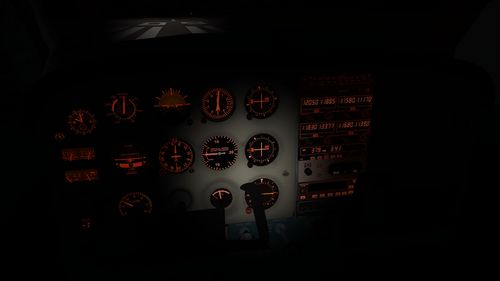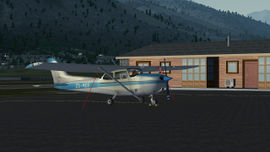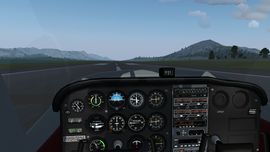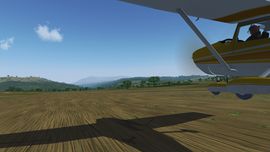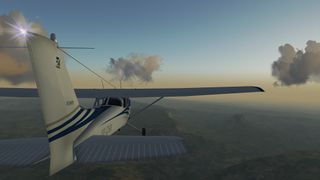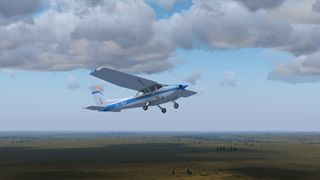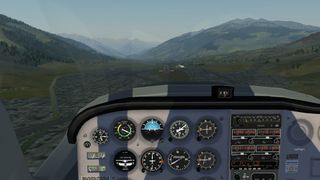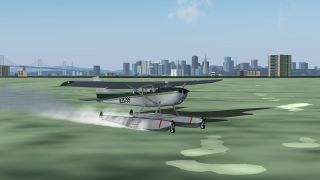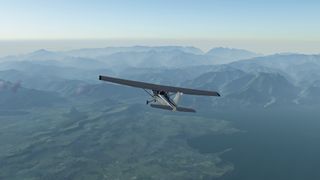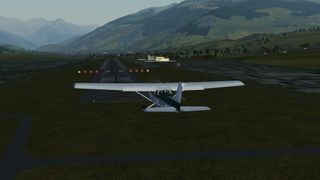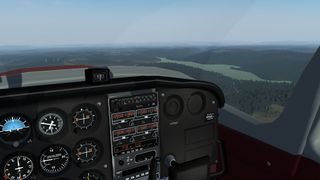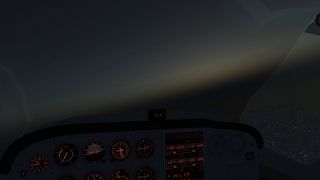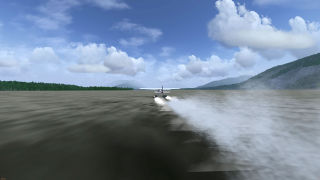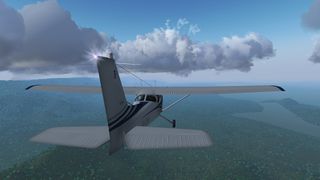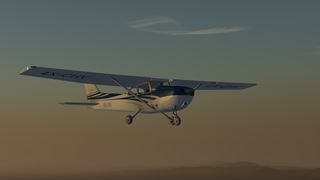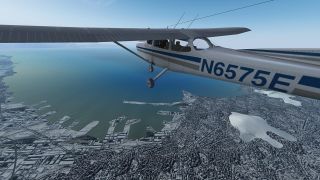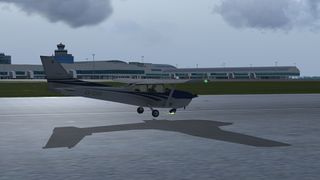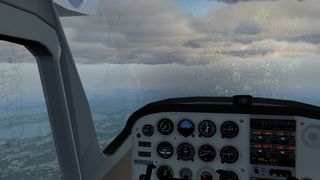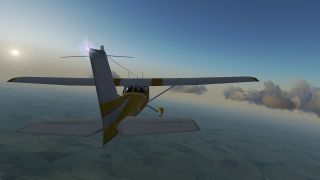Fr/Cessna 172P: Difference between revisions
(Added the Chinese translation.) |
(translation from the c172p detailed 1/2) |
||
| Line 1: | Line 1: | ||
{{BeingTranslated}} | |||
{{:{{#titleparts:{{PAGENAME}}||2}}/info}} | {{:{{#titleparts:{{PAGENAME}}||2}}/info}} | ||
Le '''Cessna 172 Skyhawk''' est un [[Fr/Avions|avion]] quadriplace, monomoteur à aile haute. Il effectua son premier vol en 1955 et est toujours en production, plus de Cessna 172 ont été construits que tout autres avions. | Le '''Cessna 172 Skyhawk''' est un [[Fr/Avions|avion]] quadriplace, monomoteur à aile haute. Il effectua son premier vol en 1955 et est toujours en production, plus de Cessna 172 ont été construits que tout autres avions. | ||
Le C 172 est l'avion par défaut dans FlightGear depuis 2000, il a remplacé le Navion. Il a eu un long développement et il inclut une grande variété de fonctionnalités pour FlightGear. | Le C 172 est l'avion par défaut dans [[FlightGear]] depuis 2000, il a remplacé le [[Navion]]. Il a eu un long développement et il inclut une grande variété de fonctionnalités pour FlightGear. En 2015, il a été complètement rénové ; cela comprend de nouvelles options de moteur, de taille de pneus ou de flotteurs, ainsi qu'une refonte complète du cockpit. Cette nouvelle version détaillée de l'avion est devenu l'avion inclus en standard depuis [[Changelog_3.6|FlightGear 3.6]]. | ||
== Contenu et variantes == | |||
The new C172p has a much better 3D model and is now fully textured (including the interior). All the switches in the cockpit are clickable. It also has an improved FDM, more complex procedures and new realistic checklists, new sound effects, and damage modelling. The aircraft can get damaged if mishandled (e.g. gear collapse after a hard landing). | |||
[[File:C172p-bodensee-panorama.jpg|center|800px]] | |||
The aircraft currently has five variants, all available from the aircraft menu: | |||
* regular wheels | |||
* 26" bush tires | |||
* 31" bush tires | |||
* pontoons | |||
* amphibian | |||
* snow skis | |||
Also, from the same menu, the user can select two different engines: | |||
* 160 HP | |||
* 180 HP (recommended when using pontoons, amphibian and skis variants) | |||
The aircraft now can get damaged from collisions, crashes, hard landings or overload while in-flight, and the modelling includes wheel collapse, wings breaking, etc. The damage can be turned off in the aircraft menu, which also contains an option for repairing the aircraft. | |||
The windows now can get foggy or frosty, depending on the combination of interior and exterior temperatures. The pilot must then use the Cabin Heat and Cabin Air levers (on the right of the flaps) to control it. Alternatively, it's possible to disable the effect in the "Aircraft Options" in the "Cessna 172P" menu. This effect depends on the new ALS effects found in 3.5 and above, and will also have the side effect of producing grey windows in versions prior to 3.5. | |||
The FDM has also been modified. The aircraft may enter into a spin in case of an asymmetric stall (a particularly dangerous situation when turning to final, in which case the aircraft is at low speed and low height). The FDM has also been tweaked to include hydrodynamics effects while taking off or landing on water, as well as adding a new 180 HP engine. | |||
There are several liveries available, some of which have higher resolution than others, which are marked as HD in the liveries menu. Each of the HD liveries also has unique cockpit and interior textures. | |||
The aircraft has a simulation of the [[Bendix/King KAP140 Autopilot]]. | |||
Also, if the user has enabled ALS (Atmospheric light scattering) in the Rendering Options, then it's possible to activate the flashlight by clicking on the "Cessna 172P" menu and selecting "Flashlight". Select it once for the white flashlight, select it again for a red one and select it one more time to turn it off. | |||
The aircraft can now go through a pre-flight: wheel chocks, tie-downs and the pitot tube cover can now be added or removed, oil management and fuel contamination by water have been implemented (both of which are not activated by default, but are available in the aircraft menu). | |||
[[File:c172p-ALS-flashlight2.jpg|500px|center|Lampe de poche du Cessna 172P's dans le cockpit]] | |||
== Aide de l'avion == | == Aide de l'avion == | ||
=== Mise en route === | === Inspection avant le vol === | ||
[[File:C172p-secured-Aosta.jpg|270px||thumb|Cessna 172P sécurisé à l'aéroport d'Aosta]] | |||
It's recommended to use any exterior view or activate the walker for these procedures. | |||
* Fuel quantity: add by clicking on the fuel tank caps above each wing | |||
* Right wing: remove tie-downs | |||
* Right wing: check for fuel contamination by clicking under the wing and take a fuel sample. If the sample is light blue, the fuel is not contaminated and can be returned to the tank. If the sample is transparent or partially transparent, you must discard it and take new samples until they are completely light blue | |||
* Nose: check for oil quantity by clicking on the oil door in the nose. Critical oil level for either engine is 5.0 quarts. | |||
* Nose: remove wheel chocks | |||
* Left wing: remove tie-downs | |||
* Left wing: remove pitot tube cover | |||
* Left wing: check for fuel contamination | |||
=== Mise en route (démarrage simple ou complexe) === | |||
* Priming: pompez le moteur au moins 3 fois | |||
* Mixture: Riche (manette rouge poussée à fond) | * Mixture: Riche (manette rouge poussée à fond) | ||
* Gaz: 1/8" (1/2 cm) | * Gaz: 1/8" (1/2 cm) | ||
* Frein de parking: Serré (Shift | * Frein de parking: Serré ({{Key press|Shift|B}}) | ||
* Zone autour de l'hélice: Dégagée | * Zone autour de l'hélice: Dégagée | ||
* Magnétos: Both (} trois fois) | * Magnétos: Both ({{Key press|<nowiki>}</nowiki>}} trois fois) | ||
* Démarreur ( | * Démarreur ({{Key press|S}}) | ||
=== Démarrage moteur (automatique avec l'Autostart) === | |||
* Dans le menu "Cessna C172P", choisissez "Autostart" puis garder la touche {{Key press|S}} appuyée pour démarrer l'avion. | |||
=== Décollage === | === Décollage === | ||
[[File:c172p-cockpit.jpg|270px||thumb|Cessna 172P prêt au décollage]] | |||
* Volets rentrés | * Volets rentrés | ||
* Plein gaz | * Plein gaz | ||
| Line 33: | Line 77: | ||
* Volets rentrés | * Volets rentrés | ||
* Plein gaz | * Plein gaz | ||
* | * 75 KIAS | ||
=== Croisière === | === Croisière === | ||
| Line 40: | Line 84: | ||
=== Atterrissage === | === Atterrissage === | ||
[[File:c172p-landing2.jpg|270px||thumb|Cessna 172P sur le point d'atterrir]] | |||
* Volets: tout sorti | * Volets: tout sorti | ||
* | * 60 KIAS | ||
=== Vitesses limites === | === Vitesses limites === | ||
== | : ''Voir aussi [[Aircraft speed#V speeds]]'' | ||
| | The information in this section is based on external resources.<ref>[http://www.triangleaviation.com/1982_172r.html Triangle Aviation]{{dead link|2015-10}}</ref><ref>[http://www.otisair.com/c172info.html OtisAir's Airborne Observations]{{dead link|2015-10}}</ref><ref>{{cite web |url=http://www.airweb.faa.gov/Regulatory_and_Guidance_Library/rgMakeModel.nsf/0/724e90061c5bf3b1862576260063e599/$FILE/3A12.pdf |title=Type Certificate No. 3A12, Revision 79 |date=27 August 2009 |work= |publisher=FAA |format=pdf |accessdate=9 October 2015}}</ref> | ||
{| class="wikitable" | |||
| | ! Vitesse(Airspeed) !! Vitesse calibrée (CAS) | ||
|- | |- | ||
| | | Vitesse de décrochage, configuration pour l’atterrissage, V<sub>S<sub>0</sub></sub> || 33 kt | ||
|- | |- | ||
| | | Vitesse de décrochage, V<sub>S<sub>1</sub></sub> || 44 kt | ||
|- | |- | ||
| | | Vitesse de rotation, V<sub>R</sub> || 55 kt | ||
|- | |- | ||
| | | Vitesse avec le meilleur angle of montée, V<sub>X</sub> || 59 kt | ||
|- | |- | ||
| | | Vitesse avec la montée la plus rapide, V<sub>Y</sub> || 76 kt | ||
|- | |- | ||
| | | Vitesse maximale avec les volets sortis, V<sub>FE</sub> || 85 kt | ||
|- | |||
| rowspan="2" valign="top" | Vitesse de manœuvre, V<sub>A</sub> || 96 kt (flotteurs) | |||
|- | |||
| 99 kt (roues) | |||
|- | |||
| Vitesse maximale de croisière pour l’intégrité structurelle, V<sub>NO</sub> || 127 kt | |||
|- | |||
| Vitesse à ne jamais dépasser, V<sub>NE</sub> || 158 kt | |||
|} | |} | ||
''' | == FAQ == | ||
Here are some of the frequently asked questions about this aircraft: | |||
'''Q:''' I am experiencing grey windows, what is happening? | |||
'''A:''' If you experience grey windows, you do not have the correct FlightGear version. This aircraft requires 3.5 or above. | |||
'''Q:''' Why does the aircraft keep turning left? | |||
'''A:''' Please see [[understanding Propeller Torque and P-Factor]]. If using the amphibian model on a solid runway, note that at the taxiing is done by differential braking (the rudder becomes more and more effective as the plane gains speed). | |||
'''Q:''' Why will the engine not start? | |||
'''A:''' You can start the engine automatically by clicking on the menu "Cessna C172P", selecting "Autostart" and then simply holding the key {{Key press|S}}. For a manual start, please follow the checklists available by clicking on the menu "Help" followed by "Aircraft Checklists". As seen above, the engine must by "primed" before starting. If oil management is activated, you must have enough oil for the engine to work (more than 5.0 quarts). If fuel contamination is activated, the fuel must be light blue in order for the engine to properly work. | |||
'''Q:''' Why does the engine die immediately after startup? | |||
'''A:''' Probably because the throttle is being incremented too fast after startup as the engine needs a few seconds to stabilize itself. | |||
'''Q:''' Why can't I start the sim with the engine running? | |||
'''A:''' You can! Go to the menu "Cessna C172P", select "Aircraft Options" and tick the option "Start with engine running". | |||
'''Q:''' Why the aircraft doesn't move? | |||
'''A:''' The aircraft won't move if you have the parking brakes set, or if either of the wing tie-downs, the tail tie-down or wheel chocks are in place (if the option "allow securing aircraft" is enabled in the aircraft menu). | |||
'''Q:''' Why the airspeed indicator doesn't work? | |||
'''A:''' If the option "allow securing aircraft" is enabled in the aircraft menu, then very likely you forgot to remove the pitot tube cover. | |||
'''Q:''' How can I switch to the bush tires/pontoons/amphibian? | |||
''' | '''A:''' By clicking in menu "Cessna 172P", selecting "Aircraft Options" and then selecting the other landing gear options. | ||
'''Q:''' How can I switch to the 180 HP engine? | |||
=== Liens === | '''A:''' This is also done by clicking in menu "Cessna 172P", selecting "Aircraft Options" and then selecting the engine power option. | ||
'''Q:''' Why can't I take off from the water without crashing the plane? | |||
'''A:''' Taking off and landing on water can be quite tricky. Try applying a little bit of back pressure on the yoke while accelerating to 55 KIAS. It's also recommended to use the 180 HP engine instead of the default 160 HP, as the extra weight of the pontoons make it really hard to climb with the default engine. | |||
'''Q:''' Why is the simulator lagging so much? | |||
'''A:''' As with any complex 3D model, this new version of the c172p is a bit more demanding on the computers than the older one. If you are having troubles with performance, try using non-HD liveries which use textures with lower resolutions, as well as other solutions that can improve performance (disabling certain graphical options in the Rendering Options, lowering the resolution of FlightGear, etc.). | |||
Some tricks that help to increase fps is by disabling all GUI windows, including the menu bar and the orange fps counters at the bottom of the screen. You can display an alternative fps counter in the top left corner via the "Debug" menu and then selecting "Cycle On-Screen Statistics". Make sure to hide the menu bar by pressing F10 to see the counter. | |||
A second trick is to simply disable the rendering of all clouds if you don't mind. Start FlightGear with "--prop:/sim/rendering/draw-mask/clouds=0". | |||
If you notice heavy slowdowns when flying over certain scenery and you see FlightGear generating many "Warning:: Picked up error in TriangleIntersect" messages in the terminal or log file, you can disable this by starting FlightGear with "--prop:/sim/rendering/osg-notify-level=fatal". | |||
'''Q:''' Why are the windows getting foggy/frosty? | |||
'''A:''' If the dew point of the cabin air temperature is higher than the surface temperature of the windshield, the windows will get either foggy or frosty. Use the Cabin Heat and Cabin Air levers (on the right of the flaps) to control it. The dew point rises with the temperature in the cabin, and it rises faster than the windshield temperature can adjust, resulting in temporary fog. If the air is very humid, the dew point is going to be very close to the cabin temperature, which makes it likely that it will be higher than the windshield temperature. Extra passengers will create a more humid atmosphere in the cabin. Try to increase air flow using the Cabin Air lever or overhead air vents in order to decrease the humidity or temperature. Alternatively, disable the effect by going to the menu "Cessna 172P", selecting "Aircraft Options" and disable the option "Enable frost and fog". | |||
'''Q:''' How do I increase the cabin air temperature? | |||
'''A:''' Increase the cabin air temperature by opening the Cabin Heat lever. In order to actually get a heated air flow, you need a medium or high EGT (Exhaust Gas Temperature -- the instrument between the yoke and the ADF instrument), and airspeed and/or sufficient propeller RPM. | |||
'''Q:''' How can I click on a switch which is being covered by the yoke? | |||
'''A:''' You can hide the yokes by clicking on them or by going to the menu "Cessna 172P", selecting "Hide/Show Yokes". | |||
== Development status/Issues/TODO == | |||
This aircraft is undergoing a constant development, which can be followed on its [https://github.com/Juanvvc/c172p-detailed repository], where a [https://github.com/Juanvvc/c172p-detailed/issues list of issues and future enhancements] can also be found. | |||
== Gallery == | |||
<gallery mode="packed"> | |||
c172p-plane5.jpg|Cessna 172P au dessus de Chapada Diamantina au Brésil | |||
c172p-plane4.jpg|Décollage à Compiegne Margny (LFAD) | |||
c172p-cockpit2.jpg|Sur le point d'attérir, demonstration du nouvel effet d'ombre ALS dans le cockpit | |||
c172p-floats.jpg|Variante avec flotteurs à San Francisco | |||
c172p-plane3.jpg|Cessna 172P at high altitude flying over Lago di Garda in Italy | |||
c172p-landing.jpg|On final at Aosta Airport (LIMW) | |||
c172p-cockpit3.jpg|The fully textured interiors of the new c172p | |||
c172p-night.jpg|A night flight, showing the instrument illumination | |||
c172p-particles.jpg|Taking off on water, showing the particle system | |||
c172p-plane1.jpg|Above Serra do Mar in Brazil | |||
c172p-plane2.jpg|Flying at sunset | |||
c172p-winter.jpg|European winter | |||
c172p-damage.jpg|Gear collapse due to heavy landing | |||
c172p-frost.jpg|If the conditions are just right, frost or fog will appear in the windows | |||
c172p-taubate.jpg|Flying above Taubate, Brazil | |||
</gallery> | |||
=== Liens externes === | |||
* [http://en.wikipedia.org/wiki/Cessna_172 Wikipedia article] | * [http://en.wikipedia.org/wiki/Cessna_172 Wikipedia article] | ||
* [http://www.atlasaviation.com/checklists/cessna-172/cessna_172_checklist.htm Cessna 172 checklists at AtlasAviation.com] | * [http://www.atlasaviation.com/checklists/cessna-172/cessna_172_checklist.htm Cessna 172 checklists at AtlasAviation.com] | ||
{{Appendix}} | |||
{{Cessna}} | {{Cessna}} | ||
Revision as of 08:57, 23 July 2016
| Cet article est en cours de traduction. |
 | |
|---|---|
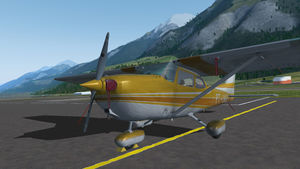 | |
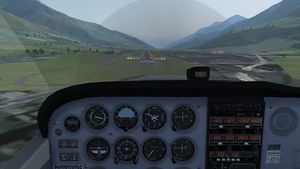 | |
| Type | Aéronef civil, Aéronef utilitaire civil, Glider tug |
| Configuration | High wing aircraft, Fixed gear aircraft |
| Propulsion | Aéronef à hélices, Aéronef monomoteur |
| Constructeur | Cessna |
| Créateur(s) |
|
| FDM | JSBSim |
| --aircraft= | c172p |
| Etat | Production avancée |
| FDM |
|
| Systèmes |
|
| Cockpit |
|
| Modèle |
|
| Soutien |
|
| Développement | |
| Référentiel |
|
| Télécharger |
|
| Livrée |
|
| Forum |
|
| Wikipédia |
Cessna 172 |
|
| |
Le Cessna 172 Skyhawk est un avion quadriplace, monomoteur à aile haute. Il effectua son premier vol en 1955 et est toujours en production, plus de Cessna 172 ont été construits que tout autres avions.
Le C 172 est l'avion par défaut dans FlightGear depuis 2000, il a remplacé le Navion. Il a eu un long développement et il inclut une grande variété de fonctionnalités pour FlightGear. En 2015, il a été complètement rénové ; cela comprend de nouvelles options de moteur, de taille de pneus ou de flotteurs, ainsi qu'une refonte complète du cockpit. Cette nouvelle version détaillée de l'avion est devenu l'avion inclus en standard depuis FlightGear 3.6.
Contenu et variantes
The new C172p has a much better 3D model and is now fully textured (including the interior). All the switches in the cockpit are clickable. It also has an improved FDM, more complex procedures and new realistic checklists, new sound effects, and damage modelling. The aircraft can get damaged if mishandled (e.g. gear collapse after a hard landing).
The aircraft currently has five variants, all available from the aircraft menu:
- regular wheels
- 26" bush tires
- 31" bush tires
- pontoons
- amphibian
- snow skis
Also, from the same menu, the user can select two different engines:
- 160 HP
- 180 HP (recommended when using pontoons, amphibian and skis variants)
The aircraft now can get damaged from collisions, crashes, hard landings or overload while in-flight, and the modelling includes wheel collapse, wings breaking, etc. The damage can be turned off in the aircraft menu, which also contains an option for repairing the aircraft.
The windows now can get foggy or frosty, depending on the combination of interior and exterior temperatures. The pilot must then use the Cabin Heat and Cabin Air levers (on the right of the flaps) to control it. Alternatively, it's possible to disable the effect in the "Aircraft Options" in the "Cessna 172P" menu. This effect depends on the new ALS effects found in 3.5 and above, and will also have the side effect of producing grey windows in versions prior to 3.5.
The FDM has also been modified. The aircraft may enter into a spin in case of an asymmetric stall (a particularly dangerous situation when turning to final, in which case the aircraft is at low speed and low height). The FDM has also been tweaked to include hydrodynamics effects while taking off or landing on water, as well as adding a new 180 HP engine.
There are several liveries available, some of which have higher resolution than others, which are marked as HD in the liveries menu. Each of the HD liveries also has unique cockpit and interior textures.
The aircraft has a simulation of the Bendix/King KAP140 Autopilot.
Also, if the user has enabled ALS (Atmospheric light scattering) in the Rendering Options, then it's possible to activate the flashlight by clicking on the "Cessna 172P" menu and selecting "Flashlight". Select it once for the white flashlight, select it again for a red one and select it one more time to turn it off.
The aircraft can now go through a pre-flight: wheel chocks, tie-downs and the pitot tube cover can now be added or removed, oil management and fuel contamination by water have been implemented (both of which are not activated by default, but are available in the aircraft menu).
Aide de l'avion
Inspection avant le vol
It's recommended to use any exterior view or activate the walker for these procedures.
- Fuel quantity: add by clicking on the fuel tank caps above each wing
- Right wing: remove tie-downs
- Right wing: check for fuel contamination by clicking under the wing and take a fuel sample. If the sample is light blue, the fuel is not contaminated and can be returned to the tank. If the sample is transparent or partially transparent, you must discard it and take new samples until they are completely light blue
- Nose: check for oil quantity by clicking on the oil door in the nose. Critical oil level for either engine is 5.0 quarts.
- Nose: remove wheel chocks
- Left wing: remove tie-downs
- Left wing: remove pitot tube cover
- Left wing: check for fuel contamination
Mise en route (démarrage simple ou complexe)
- Priming: pompez le moteur au moins 3 fois
- Mixture: Riche (manette rouge poussée à fond)
- Gaz: 1/8" (1/2 cm)
- Frein de parking: Serré (⇧ Shift+B)
- Zone autour de l'hélice: Dégagée
- Magnétos: Both (} trois fois)
- Démarreur (S)
Démarrage moteur (automatique avec l'Autostart)
- Dans le menu "Cessna C172P", choisissez "Autostart" puis garder la touche S appuyée pour démarrer l'avion.
Décollage
- Volets rentrés
- Plein gaz
- Rotation à 55 KIAS
Montée
- Volets rentrés
- Plein gaz
- 75 KIAS
Croisière
- gaz: 65%
- mixture: "rich of peak"
Atterrissage
- Volets: tout sorti
- 60 KIAS
Vitesses limites
- Voir aussi Aircraft speed#V speeds
The information in this section is based on external resources.[1][2][3]
| Vitesse(Airspeed) | Vitesse calibrée (CAS) |
|---|---|
| Vitesse de décrochage, configuration pour l’atterrissage, VS0 | 33 kt |
| Vitesse de décrochage, VS1 | 44 kt |
| Vitesse de rotation, VR | 55 kt |
| Vitesse avec le meilleur angle of montée, VX | 59 kt |
| Vitesse avec la montée la plus rapide, VY | 76 kt |
| Vitesse maximale avec les volets sortis, VFE | 85 kt |
| Vitesse de manœuvre, VA | 96 kt (flotteurs) |
| 99 kt (roues) | |
| Vitesse maximale de croisière pour l’intégrité structurelle, VNO | 127 kt |
| Vitesse à ne jamais dépasser, VNE | 158 kt |
FAQ
Here are some of the frequently asked questions about this aircraft:
Q: I am experiencing grey windows, what is happening?
A: If you experience grey windows, you do not have the correct FlightGear version. This aircraft requires 3.5 or above.
Q: Why does the aircraft keep turning left?
A: Please see understanding Propeller Torque and P-Factor. If using the amphibian model on a solid runway, note that at the taxiing is done by differential braking (the rudder becomes more and more effective as the plane gains speed).
Q: Why will the engine not start?
A: You can start the engine automatically by clicking on the menu "Cessna C172P", selecting "Autostart" and then simply holding the key S. For a manual start, please follow the checklists available by clicking on the menu "Help" followed by "Aircraft Checklists". As seen above, the engine must by "primed" before starting. If oil management is activated, you must have enough oil for the engine to work (more than 5.0 quarts). If fuel contamination is activated, the fuel must be light blue in order for the engine to properly work.
Q: Why does the engine die immediately after startup?
A: Probably because the throttle is being incremented too fast after startup as the engine needs a few seconds to stabilize itself.
Q: Why can't I start the sim with the engine running?
A: You can! Go to the menu "Cessna C172P", select "Aircraft Options" and tick the option "Start with engine running".
Q: Why the aircraft doesn't move?
A: The aircraft won't move if you have the parking brakes set, or if either of the wing tie-downs, the tail tie-down or wheel chocks are in place (if the option "allow securing aircraft" is enabled in the aircraft menu).
Q: Why the airspeed indicator doesn't work?
A: If the option "allow securing aircraft" is enabled in the aircraft menu, then very likely you forgot to remove the pitot tube cover.
Q: How can I switch to the bush tires/pontoons/amphibian?
A: By clicking in menu "Cessna 172P", selecting "Aircraft Options" and then selecting the other landing gear options.
Q: How can I switch to the 180 HP engine?
A: This is also done by clicking in menu "Cessna 172P", selecting "Aircraft Options" and then selecting the engine power option.
Q: Why can't I take off from the water without crashing the plane?
A: Taking off and landing on water can be quite tricky. Try applying a little bit of back pressure on the yoke while accelerating to 55 KIAS. It's also recommended to use the 180 HP engine instead of the default 160 HP, as the extra weight of the pontoons make it really hard to climb with the default engine.
Q: Why is the simulator lagging so much?
A: As with any complex 3D model, this new version of the c172p is a bit more demanding on the computers than the older one. If you are having troubles with performance, try using non-HD liveries which use textures with lower resolutions, as well as other solutions that can improve performance (disabling certain graphical options in the Rendering Options, lowering the resolution of FlightGear, etc.).
Some tricks that help to increase fps is by disabling all GUI windows, including the menu bar and the orange fps counters at the bottom of the screen. You can display an alternative fps counter in the top left corner via the "Debug" menu and then selecting "Cycle On-Screen Statistics". Make sure to hide the menu bar by pressing F10 to see the counter.
A second trick is to simply disable the rendering of all clouds if you don't mind. Start FlightGear with "--prop:/sim/rendering/draw-mask/clouds=0".
If you notice heavy slowdowns when flying over certain scenery and you see FlightGear generating many "Warning:: Picked up error in TriangleIntersect" messages in the terminal or log file, you can disable this by starting FlightGear with "--prop:/sim/rendering/osg-notify-level=fatal".
Q: Why are the windows getting foggy/frosty?
A: If the dew point of the cabin air temperature is higher than the surface temperature of the windshield, the windows will get either foggy or frosty. Use the Cabin Heat and Cabin Air levers (on the right of the flaps) to control it. The dew point rises with the temperature in the cabin, and it rises faster than the windshield temperature can adjust, resulting in temporary fog. If the air is very humid, the dew point is going to be very close to the cabin temperature, which makes it likely that it will be higher than the windshield temperature. Extra passengers will create a more humid atmosphere in the cabin. Try to increase air flow using the Cabin Air lever or overhead air vents in order to decrease the humidity or temperature. Alternatively, disable the effect by going to the menu "Cessna 172P", selecting "Aircraft Options" and disable the option "Enable frost and fog".
Q: How do I increase the cabin air temperature?
A: Increase the cabin air temperature by opening the Cabin Heat lever. In order to actually get a heated air flow, you need a medium or high EGT (Exhaust Gas Temperature -- the instrument between the yoke and the ADF instrument), and airspeed and/or sufficient propeller RPM.
Q: How can I click on a switch which is being covered by the yoke?
A: You can hide the yokes by clicking on them or by going to the menu "Cessna 172P", selecting "Hide/Show Yokes".
Development status/Issues/TODO
This aircraft is undergoing a constant development, which can be followed on its repository, where a list of issues and future enhancements can also be found.
Gallery
Liens externes
Références
|
| ||||||||

